
Am Fam Physician. 2005;72(3):473-478
Patient information: See related handout on car safety for your child, written by the author of this article.
Author disclosure: Nothing to disclose.
The number one cause of death for children younger than 14 years is vehicular injury. Child safety seats and automobile safety belts protect children in a crash if they are used correctly, but if a child does not fit in the restraint correctly, it can lead to injury. A child safety seat should be used until the child correctly fits into an adult seat belt. It is important for physicians caring for children to know what child safety seats are available and which types of seats are safest. Three memory keys will help guide appropriate child safety seat choice: (1) Backwards is Best; (2) 20-40-80; and (3) Boost Until Big Enough. “Backwards is Best” cues the physician that infants are safest in a head-on crash when they are facing backward. “20-40-80” reminds the physician that children may need to transition to a different seat when they reach 20, 40, or 80 lb. “Boost Until Big Enough” emphasizes that children need to use booster seats until they are big enough to fit properly into an adult safety belt.
Automobile crashes are the leading cause of death for children younger than 14 years, but safety seats reduce childhood injury and death.1–4 Child safety seat use is increasing, especially in children younger than four years.5 However, 11 percent of children still ride unrestrained, and safety device misuses that could cause a fatality may be as high as 72.6 percent.5 Evidence-based ways to increase child safety seat use include laws, community education,6,7 and counseling by family physicians. Comprehensive resources4,9,10 have been published to aid physicians in this counseling, but details may be difficult to remember. Fortunately, there are simple principles for counseling on appropriate child safety seat selection and use.
| Clinical recommendation | Evidence rating | References | Comments |
|---|---|---|---|
| Children who do not fit in a safety belt should use child safety seats when riding in a vehicle. | A | 1,2,3,7 | Child safety seats reduce injury and death. |
| Children should use a booster seat until the adult safety belt fits correctly. | B | 2,3 | Cross-sectional study and crash report review and survey study comparing injuries in children using booster seats with safety belts alone |
| Physicians should counsel parents about child safety seats. | C | 7 | |
| Infants should face the rear of the car as long as possible. | C | 8 | American Academy of Pediatrics recommendation based on studies from crash testing and injury reports |
Correct Safety Belt Fit
Automobile safety belts are designed for adults, and they must fit correctly to work properly for children. Until a child fits correctly in the safety belt, a child safety seat should be used. The safety belt fit is correct when (1) the lap belt portion is low and tight across the hips or upper thighs; (2) the shoulder portion crosses the midsternum and the midclavicle; and (3) the child can sit back against the seat back with legs bent over the front of the seat.11
Usually, the adult safety belt fits correctly when a child is 4ft 9in (145 cm) tall.12 However, this marker may not apply for all children; therefore, the above criteria should be used to determine a safe fit.
Correct Child Safety Seat Installation
Installing a child safety seat securely can be difficult because child safety seats, automobiles, and safety belt systems differ. The Lower Anchors and Tethers for CHildren (LATCH) restraint system, a feature of all safety seats in automobiles manufactured since September 1, 2001, has made it easier to install seats (Figure 1). Caregivers should be encouraged to read the safety seat manual, but it may be written at a grade level higher than the average person can read.13 Parents can ensure that they have installed the seat correctly by having it checked at a child safety seat inspection station or by a certified child passenger safety technician. Stations and technicians can be located through the National Highway Traffic Safety Administration (NHTSA) online atwww.nhtsa.dot.gov/portal/site/nhtsa/menu item.9f8c7d6359e0e9bbbf30811060008a0c or by calling 888-DASH-2-DOT; or through SeatCheck online athttp://www.seatcheck.org or by calling 866-SEAT-CHECK.
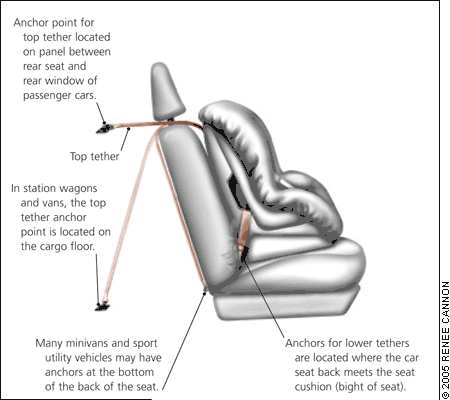
Types of Child Safety Seats
Children need different types of child safety seats as they grow. There are four main types of seats: infant seats, convertible seats, forward-facing or combination seats, and booster seats (Table 1 and Figures 2 through 514). Children with special health care needs may require different restraints. Information about safety seats for children with special needs can be found on the Web site of the American Academy of Pediatrics (AAP) athttp://www.aap.org.
| Type of restraint | Intended occupant size* | Restraint characteristics | Usage warnings |
|---|---|---|---|
| Infant seat (see Figure 2) | For children weighing up to 20 to 22 lb (9 to 10 kg) and up to 26 to 29 in (66 to 74 cm) tall; infants outgrow this seat when they are over the seat’s weight maximum or when their heads are within one inch of the top. | Faces rearward only; comes with or without a base; relatively inexpensive and lightweight; portable, can be used as a baby carrier | Never use a rear-facing seat in a front seat where there is an airbag; harness straps should be flat and snug on the child; seat needs to be secured tightly with the safety belt or LATCH restraint system. |
| Convertible seat (see Figure 3) | Most accommodate infants and toddlers weighing 20 to 40 lb (9 to 18 kg) and up to 40 in (102 cm) tall (some seats are designed for larger children, check the label); for infants younger than one year but heavier than 20 lb, select a seat with a high enough rear-facing weight limit. | Faces rearward for infants and forward for toddlers; accommodates a larger age range; child needs to be removed from the seat to exit the automobile | Never use a rear-facing seat in a front seat where there is an airbag; harness straps should be flat and snug on the child; seat needs to be tightly secured with the safety belt or LATCH restraint system. |
| Forward-facing seat or combination seat (see Figure 4) | Most are for children weighing 30 to 40 lb (14 to 18 kg) (some allow for 20 to 40 lb); the height limits vary from 50 to 57 in (127 to 145 cm). | Forward-facing seats can only face forward; combination seats have a removable harness system so the seat can be used later as a booster seat | Harness straps should be flat and snug on the child; harness system should not be used past the seat’s weight limit; convertible seat needs to be secured tightly to the automobile with the safety belt or LATCH restraint system. |
| Booster seat, high-back booster, and backless booster (see Figure 5) | Used when child no longer fits in other child safety seats but is not big enough for the safety belt; should be used until the safety belt fits properly | Used with an adult lap and shoulder belt; are not attached to the automobile | Should only be used in a seating position where there is a shoulder and lap belt; high-back seats and backless seats are good in most situations; if the back of the automobile seat or headrest is below the ears of the child, use a high-back booster. |
| Lap and shoulder automobile safety belt | Used when the child fits correctly in them (usually when child is 4ft. 9in. in tall); correctly fits when the child is tall enough to have legs bent over the seat when back is against the seat, shoulder belt fits across the midclavicle and midsternum, and lap belt is low and tight across the thighs | A safety belt with a shoulder belt offers better protection than the lap belt alone; if the safety belt is uncomfortable, it may not fit correctly, so a booster seat may be needed. | Incorrectly fitting safety belts can cause injury, or the child can slip out of the safety belt; the shoulder belt should not be put behind the back or under the arm. |
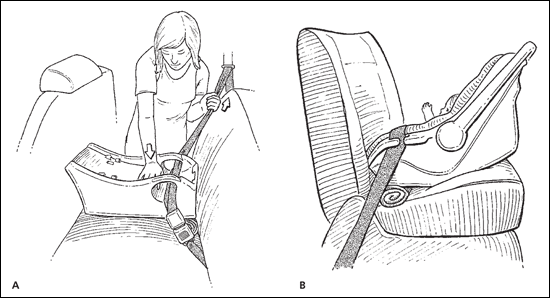
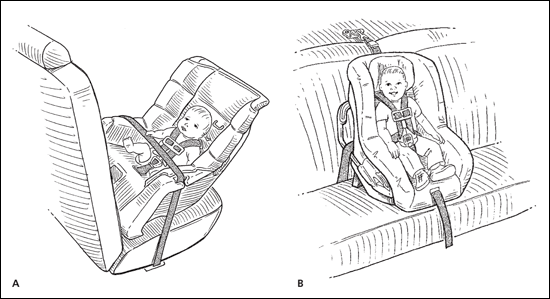
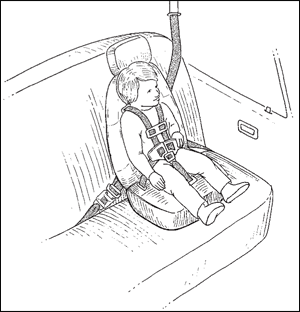
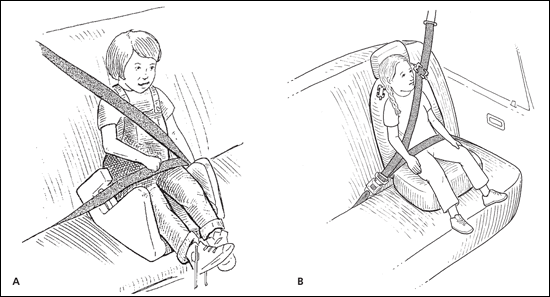
Individual child safety seats are designed to fit children of specific heights and weights. If the child is too big, the seat could fail (e.g., harness system ripping, buckle breaking, plastic shattering). Federal Motor Vehicle Safety Standard 213 requires that all child safety seats be labeled with height and weight limits.15 Parents should be instructed to look for this label and change the seat when the child outgrows it. If the label is no longer readable, the parent can call the manufacturer or check the instruction manual. Patient information about safety seat use and recalls can be found on the Web sites of the AAP (http://www.aap.org), the American Academy of Family Physicians, (https://familydoctor.org), and the NHTSA (http://www.nhtsa.gov).
Three Keys to Safety
Physicians not only need to know the types of child safety seats, but also the principles on how to choose which seat is best. Three memory cues help guide parental counseling: (1) Backwards is Best; (2) 20-40-80; and (3) Boost Until Big Enough.
BACKWARDS IS BEST
An infant should ride backwards (rear facing) as long as possible. Facing the rear minimizes the risk of head and neck injury in the event of a crash. In a frontal crash, the back of the safety seat supports the child’s head and neck. If an infant is facing forward, the harness restrains the body, but the head and neck remain unrestrained and whip forward in rapid flexion, potentially causing injury.
To reduce the risk of cervical spine injury in a crash, the AAP recommends children ride backwards, at least until they are both one year of age and weigh 20 lb (9 kg). Children who weigh more than 20 lb but are younger than one year need a safety seat that accommodates facing backward for heavier weights. For optimal protection, infants should continue to ride backward until they reach the seat’s height and weight limits.4 The AAP recommendations for counseling parents about choosing the appropriate safety seat for their child can be found online athttp://pediatrics.aappublications.org/content/109/3/550.full.
20-40-80
There are three weights at which children most likely need to transition from one child safety seat to another: 20 lb (9kg), 40 lb (18 kg), and 80 lb (36 kg). Most infant seats have a size limit of 20 lb or 26 inches (66 cm). Most forward-facing seats and convertible seats have limits of 40 lb or 40 inches (102 cm). Most adult safety belt systems do not fit children who weigh less than 80 lb or are shorter than 57 inches, necessitating a booster seat until the child fits into the safety belt.
Height limits are as important as weight limits when determining if a child safety seat is appropriate. For example, tall, thin children usually exceed the height limit before the weight limit. So the “20-40-80” memory key only reminds physicians of usual transition times for when a child may need a new seat. At these times, parents should be advised to look for specific height and weight limits on the label and use these limits to decide when to transition to a new seat.
BOOST UNTIL BIG ENOUGH
A booster seat should be used until children are big enough to fit in an adult safety belt. Booster seats raise a child up in the seat so that the safety belt fits correctly, better protecting the child from crash and safety belt injury. In a crash, if a child who is too small uses a safety belt alone, injury may result.3 For example, the child can slip out of an incorrectly fitting belt during a crash; or, if the shoulder belt is on the neck, it can cause neck injury. The child also can slip under the lap belt, and this can lead to abdominal injuries such as liver laceration or splenic rupture.11
State laws vary regarding when to use a booster seat. For example, in Oregon there is a “6 and 60” law16 that requires children younger than six years and lighter than 60 lb (27 kg) to ride in a child safety seat. NHTSA lists state child restraint laws online athttp://www.nhtsa.gov. It is important to realize that laws may not represent the safest practice. Physicians should be aware of pertinent laws and be prepared to educate parents on why it may be unsafe to use an adult safety belt alone before it fits.
Many parents incorrectly believe that their child is too old for a child seat or a booster seat.17 Physicians must remember there is no specific age, weight, or height at which it is safe for all children to use an adult safety belt system. Education should be directed toward teaching parents when their child can transition to a safety belt.
After the Child Safety Seat
Once the child is large enough for the safety belt to fit correctly, a belt system with a shoulder and lap belt is ideal. Lap belts alone are better than no restraint, but because they offer no upper body protection, they are inferior to those with a shoulder and lap belt. Shoulder and lap safety belts are designed to work as a system. The shoulder belt should not be placed behind the back because the upper body will not be restrained, and the belt may not work in this configuration. The shoulder belt portion should never be placed under the arm because the force of a crash could cause the belt to fracture ribs, cause brachial plexus injury, or result in other chest wall and upper extremity injury. To reduce safety belt injury, parents should be instructed to avoid these common misuses of adult safety belts.